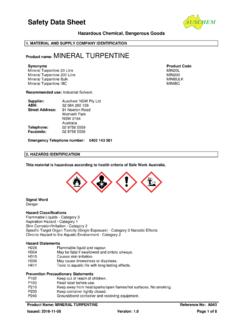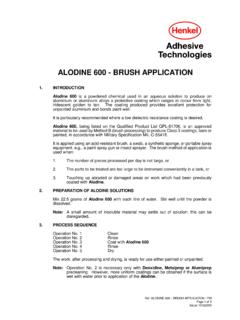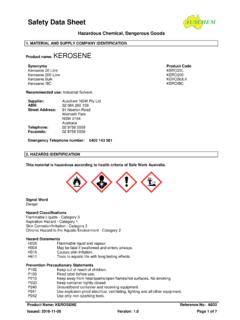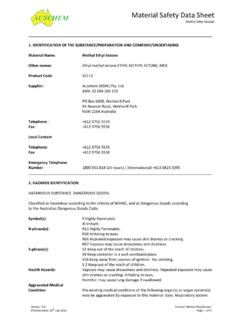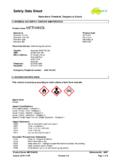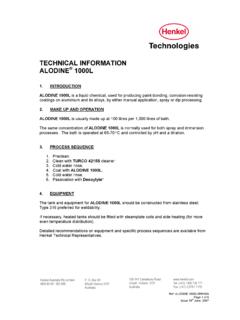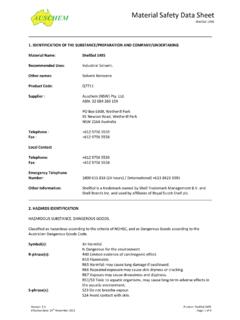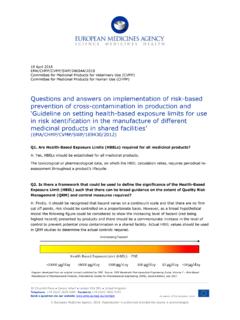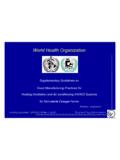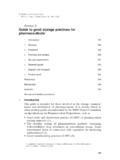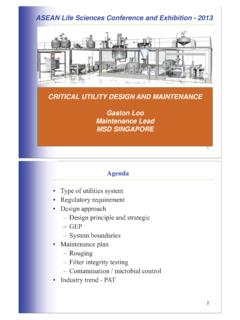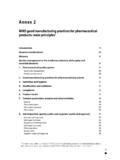Transcription of Hazardous Chemical, Dangerous Goods - Solvents
1 Safety Data Sheet Product Name: ALL PURPOSE THINNERS #1 Reference No: A003 Issued: 2016-11-08 Version: Page 1 of 8 Hazardous chemical , Dangerous Goods 1. MATERIAL AND SUPPLY COMPANY IDENTIFICATION Product name: ALL PURPOSE THINNERS #1 Synonyms Product Code All Purpose Thinners #1 20 Litre ALL120L All Purpose Thinners #1 200 Litre ALL1200 All Purpose Thinners #1 IBC ALL1 IBC Recommended use: General Purpose Paint Thinner. Supplier: Auschem NSW Pty Ltd ABN: 32 084 260 159 Street Address: 91 Newton Road Wetherill Park NSW 2164 Australia Telephone: 02 9756 5559 Facsimile: 02 9756 5558 Emergency Telephone number: 0402 143 581 2. HAZARDS IDENTIFICATION This material is Hazardous according to health criteria of Safe Work Australia.
2 Signal Word Danger Hazard Classifications Flammable Liquids - Category 2 Skin Corrosion/Irritation - Category 2 Serious Eye Damage/Irritation - Category 2A Toxic to Reproduction - Category 2 Specific Target Organ Toxicity (Single Exposure) - Category 3 Respiratory Tract Irritation Specific Target Organ Toxicity (Repeated Exposure) - Category 2 Chronic Hazard to the Aquatic Environment - Category 3 Hazard Statements H225 Highly flammable liquid and vapour. H315 Causes skin irritation. H319 Causes serious eye irritation. H335 May cause respiratory irritation. H361 Suspected of damaging fertility or the unborn child . H373 May cause damage to organs through prolonged or repeated exposure. H412 Harmful to aquatic life with long lasting effects.
3 Prevention Precautionary Statements P102 Keep out of reach of children. P103 Read label before use. Safety Data Sheet Product Name: ALL PURPOSE THINNERS #1 Reference No: A003 Issued: 2016-11-08 Version: Page 2 of 8 P201 Obtain special instructions before use. P202 Do not handle until all safety precautions have been read and understood. P210 Keep away from heat/sparks/open flames/hot surfaces. No smoking. P233 Keep container tightly closed. P240 Ground/bond container and receiving equipment. P241 Use explosion-proof electrical, ventilating, lighting and all other equipment. P242 Use only non-sparking tools. P243 Take precautionary measures against static discharge. P260 Do not breathe dust, fume, gas, mist, vapours or spray.
4 P261 Avoid breathing dust, fume, gas, mist, vapours or P264 Wash hands, face and all exposed skin thoroughly after handling. P271 Use only outdoors or in a well-ventilated area. P273 Avoid release to the environment. P281 Use personal protective equipment as required. Response Precautionary Statements P101 If medical advice is needed, have product container or label at hand. P302+P352 IF ON SKIN: Wash with plenty of soap and water. P303+P361+P353 IF ON SKIN (or hair): Remove/Take off immediately all contaminated clothing. Rinse skin with water/shower. P304+P340 IF INHALED: Remove victim to fresh air and keep at rest in a position comfortable for breathing. P305+P351+P338 IF IN EYES: Rinse cautiously with water for several minutes.
5 Remove contact lenses, if present and easy to do. Continue rinsing. P308+P313 IF exposed or concerned: Get medical advice/attention. P312 Call a POISON CENTER or doctor/physician if you feel unwell. P314 Get medical advice/attention if you feel unwell. P332+P313 If skin irritation occurs: Get medical advice/attention. P337+P313 If eye irritation persists: Get medical advice/attention. P362 Take off contaminated clothing and wash before reuse. P370+P378 In case of fire: Use water fog (or if unavailable fine water spray), foam, dry agent (carbon dioxide, dry chemical powder) for extinction. Storage Precautionary Statements P403+P233 Store in a well-ventilated place. Keep container tightly closed. P403+P235 Store in a well-ventilated place.
6 Keep cool. P405 Store locked up. Disposal Precautionary Statement P501 Dispose of contents/container in accordance with local, regional, national and international regulations. Poison Schedule: S6. Poison Dangerous good CLASSIFICATION Classified as Dangerous Goods by the criteria of the "Australian Code for the Transport of Dangerous Goods by Road & Rail" and the "New Zealand NZS5433: Transport of Dangerous Goods on Land". Dangerous Goods Class: 3 3. COMPOSITION INFORMATION chemical ENTITY CAS NO PROPORTION Methyl ethyl ketone 78-93-3 10-30 % (w/w) Toluene 108-88-3 >60 % (w/w) Ingredients determined to be Non- Hazardous Balance Safety Data Sheet Product Name: ALL PURPOSE THINNERS #1 Reference No: A003 Issued: 2016-11-08 Version: Page 3 of 8 4.
7 FIRST AID MEASURES If poisoning occurs, contact a doctor or Poisons Information Centre (Phone Australia 131 126, New Zealand 0800 764 766). Inhalation: Remove victim from exposure - avoid becoming a casualty. Remove contaminated clothing and loosen remaining clothing. Allow patient to assume most comfortable position and keep warm. Keep at rest until fully recovered. Seek medical advice if effects persist. Skin Contact: If skin or hair contact occurs, immediately remove contaminated clothing and flush skin and hair with running water. Continue flushing with water until advised to stop by the Poisons Information Centre or a Doctor; or for 15 minutes and transport to Doctor or Hospital. For gross contamination, immediately drench with water and remove clothing.
8 Continue to flush skin and hair with plenty of water (and soap if material is insoluble). For skin burns, cover with a clean, dry dressing until medical help is available. If blistering occurs, do NOT break blisters. If swelling, redness, blistering, or irritation occurs seek medical assistance. Eye contact: If in eyes, hold eyelids apart and flush the eyes continuously with running water. Continue flushing until advised to stop by the Poisons Information Centre or a Doctor; or for at least 15 minutes and transport to Doctor or Hospital. Ingestion: Rinse mouth with water. If swallowed, do NOT induce vomiting. Give a glass of water to drink. Never give anything by the mouth to an unconscious patient.
9 If vomiting occurs give further water. Seek medical advice. Notes to physician: Treat symptomatically. 5. FIRE FIGHTING MEASURES Hazchem Code: 3YE Suitable extinguishing media: If material is involved in a fire use alcohol resistant foam or dry agent (carbon dioxide, dry chemical powder). Specific hazards: Highly flammable liquid and vapour. May form flammable vapour mixtures with air. Flameproof equipment necessary in area where this chemical is being used. Nearby equipment must be earthed. Electrical requirements for work area should be assessed according to AS3000. Vapour may travel a considerable distance to source of ignition and flash back. Avoid all ignition sources. All potential sources of ignition (open flames, pilot lights, furnaces, spark producing switches and electrical equipment etc) must be eliminated both in and near the work area.
10 Do NOT smoke. Fire fighting further advice: Heating can cause expansion or decomposition leading to violent rupture of containers. If safe to do so, remove containers from path of fire. Keep containers cool with water spray. On burning or decomposing may emit toxic fumes. Fire fighters to wear self-contained breathing apparatus and suitable protective clothing if risk of exposure to vapour or products of combustion or decomposition. 6. ACCIDENTAL RELEASE MEASURES SMALL SPILLS Wear protective equipment to prevent skin and eye contamination. Avoid inhalation of vapours or dust. Wipe up with absorbent (clean rag or paper towels). Collect and seal in properly labelled containers or drums for disposal.
